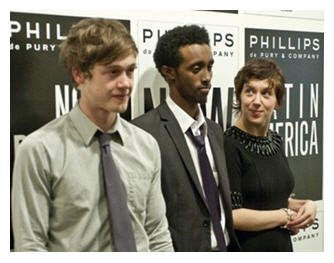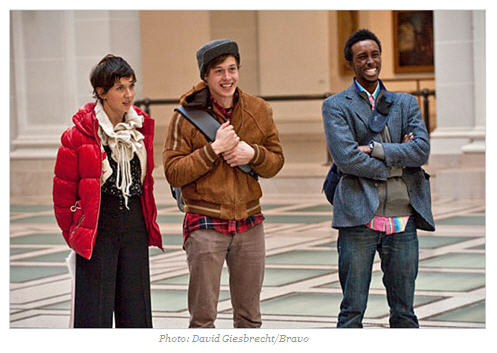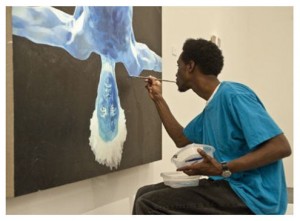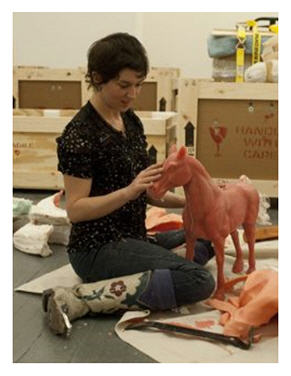 We sneered. We jeered. We cheered.
We sneered. We jeered. We cheered.
No, it wasn’t a sporting event. It was Reality TV – with fourteen artists at the starting line, three down to the wire, and one who took home the prize. Who would have thought that Work of Art would spark so much interest?
Who would have imagined that Abdi Farah would come from behind to nab the win?
It’s the morning after, and I’ll spare you a perky play-by-play through my personal lens. But I’ll offer some related thoughts. About you. About me. About why you should feel good today, even if you don’t watch this show.
In the aftermath of this strange experiment, I’m running on too little sleep (and too damn much popcorn). I was discussing art on the phone with a friend into the wee hours, having chatted with others via Twitter and email.
Consider this:
- One year ago, even the thought of this show raised the ire of artists and art lovers alike.
- Following the first episode, the art world continued to take a derisive stance; must I remind you of The Daily Beast terming this a bust?
- At mid-series, heated by the hurling of expletives and stirring the personality pot, we were appalled. And hooked.
- In the final challenges, we still bitched and moaned about time and content, insisting that fine art is different from other creative endeavors (I believe it is), as we jeered the judges (when we saw fit), and cheered our favorite contestants.
- By the finale, we were invested.
And apparently, “we the viewers” weren’t the only ones. To read Jerry Saltz’s recaps is somehow reassuring. As art critic and judge on Work of Art, he was invested as well. Apparently, to his surprise.

Reality TV as cultural mirror
Why is this about you, and me, and cause for optimism?
“Regular people” are talking about art. Tweeting about it, commenting on it, arguing over it.
Sure – we all know that reality TV is not reality. It is a cultural mirror, and a distorted one at that. It casts strange reflections as we peer in. Reflections that make us smirk, surprise us, irritate us, and unnerve us. They’re fun house mirrors in a way, forcing us to see differently whether we want to or not. We can avert our eyes or hurry by. Or we can choose to look. And if we do? Isn’t this what contemporary art is about? A different vision, purposely torqued, encouraging us to explore?
 I have higher hopes for a society that values creativity and dialogue – the communication that takes place as individuals open their eyes to see, their mouths to speak, and then quiet themselves to consider – subsequently picking up their pens, pencils, charcoals, and brushes to express themselves.
I have higher hopes for a society that values creativity and dialogue – the communication that takes place as individuals open their eyes to see, their mouths to speak, and then quiet themselves to consider – subsequently picking up their pens, pencils, charcoals, and brushes to express themselves.
Work of Art’s Participants
My thoughts on Peregrine, Miles, and Abdi?
Peregrine crafted her circus atmosphere, and a hodge-podge of elements that amply enhanced the country fair feeling she was after. In her own way, the theme of death rippled through her carnival, as it did with Miles’ and Abdi’s works. But despite her mix of installation, performance, sculpture, painting and photography – not to mention the seductive side show aspects of disembodied waxen heads and the dead, twinned fawns – her abundance of happenings weren’t to my taste. Had she edited (which would have helped), it still wouldn’t be my thing. Judging art remains subjective.
 Miles also dealt with death, and solely death, retaining a cool distance from the emotion of it. I would have had no issue with that, if the images were more compelling – larger, fewer, more diverse – more something.
Miles also dealt with death, and solely death, retaining a cool distance from the emotion of it. I would have had no issue with that, if the images were more compelling – larger, fewer, more diverse – more something.
It has been said elsewhere: Miles defeated himself. I admire that he followed a concept from start to finish, from life at the edge of death, to death, and the ultimate invisibility of a homeless man who freezes on a park bench and then disappears from our consciousness. Yet Miles abstracted the scene to the point of obliteration – the black hole and then the blur. It didn’t impress.
Yes, I’m surprised that Abdi won. And I believe it was the right choice given the final exhibition. He’s accomplished, and open. He wisely included works in charcoal, a solid mix of paintings, and sculpture – showcasing his proficiency in many mediums. The effectiveness of his sprawled selves on the gallery floor was the kicker, as he hit on universal humanistic themes of death and spirituality with a result that was skilled, edited, and accessible.
Next great anything?
 We’ve gone beyond 15 minutes of fame (thank you, Google), and somewhere, the spirit of Andy Warhol is chuckling. I think he’d be enjoying the buzz, the “good” art, the “bad” art, the redefinitions bound to take place as we make room for the fluidity of judgment in an online and interactive world.
We’ve gone beyond 15 minutes of fame (thank you, Google), and somewhere, the spirit of Andy Warhol is chuckling. I think he’d be enjoying the buzz, the “good” art, the “bad” art, the redefinitions bound to take place as we make room for the fluidity of judgment in an online and interactive world.
Is Abdi the next great artist? Of course not. There is no such thing. But he’s earned an opportunity, as have all the participants, and we’ll be watching to see what he – and they – do with it.
As for us – the viewers, the pundits, the snarky voices and the encouraging ones, we’d like more. Whether this is a blip on the art world radar or something else, many of us have loved the ride.
A bigger sandbox, a different playground
Beyond Manhattan and L.A., plenty of people still give a damn about art. We hate that galleries have closed, that museum attendance is down, that budgets for art programs in our schools are cut over and over again. We believe the artistic sandbox should be bigger – and playing there should be encouraged. Who are we without our artists, even when they make us uncomfortable?
As for art criticism, we’ve discovered that it may be interactive rather than static, a conversation in place of a sermon from the mount. Formal art criticism still has its place, but the fascination with this show, and the enthusiastic squirming of so many indicate that we care a whole lot more about the visual arts and artists than we realized.
Jerry Saltz says it far more eloquently in his remarks posted last night – and I urge you to read his recap in entirety.
. . . there’s one more question I have to ask. Did I “win” or “lose” by being on the program? Art and TV have always been bad bedfellows; they never get one another. If watching this show sometimes made the hairs on the back of my neck stand up, I can only imagine what it did to the hairs on the back of the collective neck. Yet I honestly never thought of saying no to this show. I loved doing it; it changed the way I think — somewhat, anyway. I wanted to see if art criticism was porous and supple enough to actually exist on a different stage.
And it did.
. . . For me the deep content of being on Work of Art was to see if art criticism could find new ways to expose itself to the world so that more of the world might expose itself to it. Many art world gate-keepers tut-tut that this conversation in the vernacular between equals is “piddle.” What I learned from doing this strange TV show, whose strangeness still somehow feels familiar, is that criticism contains multitudes.
Images courtesy Bravo TV.
Anything that creates a bigger sandbox and encourages us all to play more is good. Art is more necessary then we often admit. There are things we cannot say in words.
I love that reality tv — for all its muck and sensationalism — has exposed “the masses” to the idea of art and design and creativity being natural, crucial elements of our world. For every cringe worthy comment or action, there are 100s of eyeballs turning to see what the fuss is about. That is a great thing.
I love how you put a positive spin on art on TV. I never saw the show and don’t have any non-cyberspace-friend who’s talked about it so I can’t speak for the shows popularity here.
In my bubble of a town, every other person seems to be engaged in some artistic pursuit whether its filmmaking, music, dance, written or what not. Our local politicians turn their offices into galleries for budding artists. Our cafes, restaurants, clubs etc. showcase art and artists on a daily basis. It’s a great place to be one of many with healthy competition. What bothers me every now and then is when a critic or audience-turned-critic makes comments as though, opposite of what you say, judging art is not subjective. From where I stand, there’s no shortage of discussion about what’s “good” and what’s “bad” art (and folks here can be brutal about it).
What I’d like to see more of is regular folks (meaning folks who don’t consider themselves artists) taking a stab at something artistic and really appreciating how vulnerable it is to be on the other side of the criticisms. I think that hotseat could bring about some interesting discussions.
Belinda, I appreciate your remarks. There are certainly criteria as to what makes some artistic outputs “better” than others, but the issue of personal preference and taste can’t be denied.
For example, I love Willem de Kooning, Richard Diebenkorn, Pierre Alechinsky, Gerhard Richter, Agnes Martin, Lee Krasner, Alex Katz, and more and more and more. . . Can I say why? Yes and no. Very different artists? Yep. (Note the synergies between Abstract Expressionist Krasner and CoBrA artist Alechinsky.)
You might like Picasso, Renoir, and Georgia O’Keeffe, but only her flowers. Can you say why? Maybe. Maybe not. We respond to certain things at certain points in time. But the eye can also be trained to see more, and appreciate more – and to me – that is a significant part of art criticism. Education, without filling in all the gaps. Leaving space for each person to discover something.
How fortunate that you are in an area that supports budding artists. Take full advantage. Artists feed our spirits and also enliven our social consciousness. Other cultures revere their creative communities. Sadly, we don’t seem to.
Your idea of putting some of those judgmental art enthusiasts in the hot seat is a terrific one! It might well change their perspective, and allow them to comment in ways that are less about them, and more about the work they’re viewing.
We’re out of area for cable – can you believe that’s still possible? – but I would have enjoyed this show. You made good on your introduction, though – I do feel good. I do feel optimistic. Engaging more people in art and leaving them hungry for more is an exciting feat.
No cable? (I’d require even more stacks of books all over the floor, and a stash of hidden chocolate.) So glad you agree! (Seen any interesting art lately?)
Oh – and love Belinda’s tables-turning idea regarding everyday creativity vs. criticism. I’ve taken loads of groups of students through art galleries and museums, and even though I know to expect it, I still wince when I hear “Please – I could do that.”